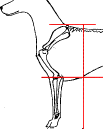


|
FOREQUARTERS |
|
|
|
Discussion Notes: |
|
|
1. The shoulder and upperarm should not show any sign of looseness. 2. If (i), (ii) and (iii) above are evident then the shoulder will be "sloping well to the back" (as illustrated in Figure A). The degree of slope required is not stated but it is important to note that an upright shoulder will result in high shoulder placement and in turn will shorten, in appearance, the length of the neck and the length of the stride in action. If the front feet are almost in a straight line with the chin (as illustrated in the three figures below) it indicates incorrect bone length and consequently incorrect angles. The three pictures below indicate the possible placement of the shoulder, upperarm and forearm; on this dog it is impossible to draw a correct anatomical picture. |
  |
 |
 |
 |
|
3. The forelegs are straight when viewed from the front (as illustrated in Figure C) and are separated by a fairly deep and wide chest (also refer to BODY) which precludes a pinched front and incorrect feet placement (as illustrated in Figure D). |
|